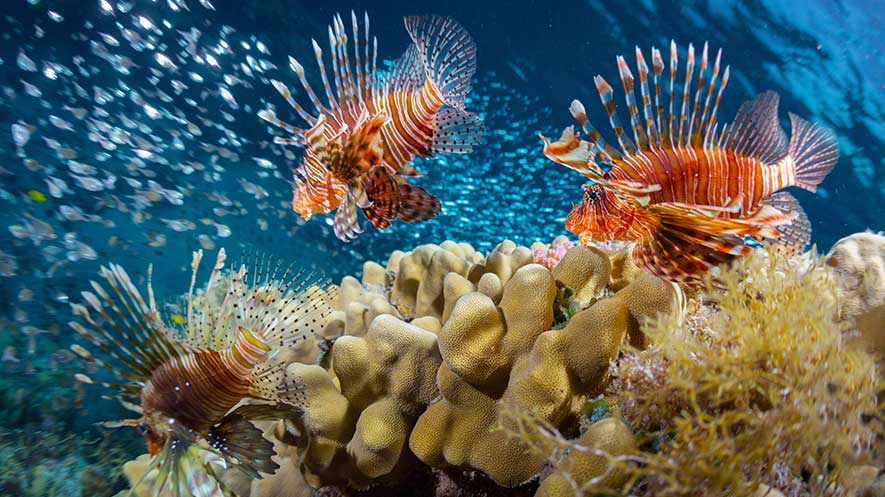Marine invasive species are hard to eradicate. The voracious lionfish has proven especially aggravating, not only due to the negative impact it has on native species and habitat, but because it is rarely caught by hook or trap. And the methods that do work, such as hand-held nets and spearfishing, simply do not harvest enough fish to knock down the exploding lionfish population.
And let’s not forget, while hand nets can be used to capture lionfish, those colorful spines contain venom and can cause painful injuries. No wonder lionfish aren’t controlled by natural predators in places like Florida or Bermuda.
But what if there was a predator that only targeted lionfish?
At least two companies are betting that if they can build a device to automatically detect and collect lionfish, they can profit. Lionfish are in fact quite tasty when properly prepared and aside from various derbies, cook-offs, and other organized events, many wholesale seafood dealers will purchase freshly caught lionfish.
One company hoping to cash in by harvesting lionfish is a startup called American Marine Research Company. They’ve already build their first drones and have been in the Florida Panhandle since 9 June 2017, trying to collect enough lionfish to clear a profit by mid-summer.
Fresh Ideas from Young Engineers
“We’re building an artificial predator for a species that doesn’t have a natural one,” Yuan Wang, 23, co-founder of American Marine Research told the Pensacola Times.
The have some engineering credentials, too. As recent graduates of M.I.T., Princeton, Olin and Cornell, the four focused their collective talents on designing aquatic drones that can dive to the extreme depths where lionfish colonize beyond the reach of human harvesters. The team believes it can program the drone to recognize lionfish, while ignoring other species.
“Our drones are very high precision,” Yuan Wang told the Pensacola Times. “It’s not like a trap or a net. We’re confident enough in our remote operators as well as our artificial intelligence that we believe we can achieve a 95 percent hit rate.”
After building several prototypes, this summer’s field testing should establish which of the test models is most effective at navigating below 1,000 feet, capturing lionfish, and leaving other species be. Along the way, they’ve had success and failure, with some models failing, while others have proven both agile and powerful. Wang says that one model could pull a 200-pound human across a pool about as fast as a person can swim. The intent, however, is to eliminate any need for humans to dive deep in the fight against this colorful invasive.
“We don’t know if we’ll succeed,” Wang says, “but it won’t be for a lack of trying.”
Kickstarting the Hunt
Like the lionfish population, the number of companies trying to engineer an artificial lionfish predator is growing. Well, maybe not quite like lionfish. Mature lionfish spawn around 2 million eggs per year.
In April 2017, Robots in Service of the Environment (RSE) unveiled a functional design prototype in one of the very places where the fish are gorging on at least 70 different species of reef fish and crustaceans: Bermuda. Like the design from American Marine Research, one of the key specifications is the ability to operate at depths below 1000 feet.
“Sharks are no longer the apex predator,” says a promotional video create by RSE. “The lionfish has invaded the Atlantic Ocean. Having no natural predators, Lionfish will decimate fisheries and destroy vital coral reefs.”
Their proposed solution, the Guardian LF1 gests up close, stuns the fish, and sucks it into a secure chamber. You can see a demo video of the drone here:
At the same time, RSE launched a crowdfunding campaign to support the final development of the robot as well as resources to bring it to market in scale. They blew past their $25,000 goal by June. 179 backers pledged $29,465 to help bring this project to life.
“We are entering an exciting new phase of development right now taking what we learned from our first prototype testing and building a small fleet of an improved version to be tested in real world conditions. This will take some time, but we can't wait to get back in the deep water finding and capturing lionfish in large numbers,” said an update on their Kickstarter page.
Are you a company working to eradicate an invasive marine species? ECO would love to hear from you. Drop us a line at This email address is being protected from spambots. You need JavaScript enabled to view it.. We’ll be glad to include you in our newsletter. At least one high-resolution image should accompany press releases.
By: Greg Leatherman





